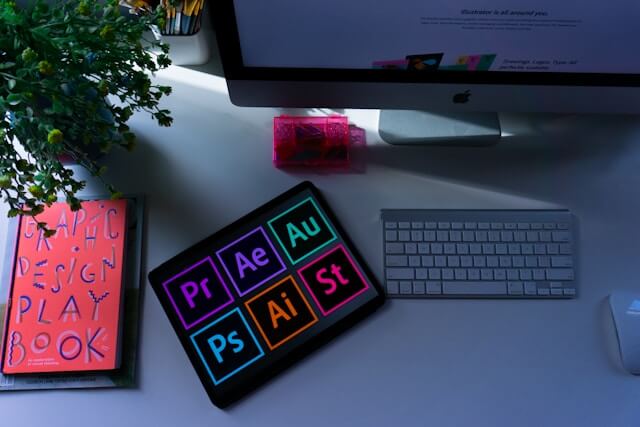For the job seekers out there, you’ve probably noticed how it’s nearly impossible to scroll through a job board without bumping into a creative gig. A copywriter here, a graphic designer there, a videographer somewhere else… Creativity is in high demand, which isn’t at all that surprising when you consider the AI fluff making rounds all over the internet. While AI tools have made content production easier, ironically, they’ve also made original, well-designed work even more valuable. So today, I thought we’d take a look at the best courses you can take to learn graphic design online, ones that actually equip you with marketable skills, whether you’re just starting out or sharpening your niche.
1. CalArts Graphic Design Specialization (Coursera)
One of the most respected starting points for anyone serious about graphic design is the CalArts Graphic Design Specialization on Coursera. Developed by the California Institute of the Arts, this program reads like a condensed design school syllabus. It introduces you to the foundations: typography, image-making, composition, branding, and then pushes you into a capstone project that simulates real-world creative demands. It’s ideal for complete beginners and self-taught creatives looking to organize their knowledge in a structured way. And because it’s hosted on Coursera, it’s flexible and relatively affordable. A certificate from CalArts is a nice touch, too.
What it is: A five-course series from the California Institute of the Arts hosted on Coursera.
What it covers: Design fundamentals, typography, image-making, branding, and a final capstone project.
Who it’s for: Beginners who want a strong foundation in classic graphic design concepts before moving into tools like Photoshop or Illustrator.
Why it’s worth it: It’s structured like a real design school syllabus but flexible and affordable. You also earn a certificate from CalArts, which holds some prestige.
You can find it here: CalArts on Coursera
2. Graphic Design Masterclass – Learn Great Design (Udemy)
If you’re more inclined toward practical, tool-heavy training, the Graphic Design Masterclass by Lindsay Marsh on Udemy is a standout. It walks you through Adobe’s holy trinity: Photoshop, Illustrator, and InDesign, while applying each skill to hands-on branding and layout projects. You don’t just learn how to use tools; you learn why to use them in certain ways, which I find even more important. The course suits aspiring freelancers or small business owners who need to produce polished, professional content without hiring out. Plus, once you enroll, you have lifetime access to all updates.
What it is: A comprehensive, self-paced course by instructor Lindsay Marsh on Udemy.
What it covers: Practical design theory, color, layout, and branding across Adobe Photoshop, Illustrator, and InDesign.
Who it’s for: Aspiring freelancers and entrepreneurs looking for hands-on, project-based learning.
Why it’s worth it: You’ll actually create real client-style projects. Plus, lifetime access means you can return anytime for refreshers or new content.
More info here: Graphic Design Masterclass on Udemy
How to Align Online Learning with Job Requirements: A Guide to Boost Career Skills
3. Google UX Design Professional Certificate (Coursera)
For those interested in user experience and interface design, the Google UX Design Professional Certificate is a modern classic. Created by actual UX professionals at Google, this course goes beyond visual aesthetics as it teaches you how to research users, design wireframes, prototype with tools like Figma, and test usability. If you’re a graphic designer wanting to change into tech or app development, this is your springboard. It’s beginner-friendly but doesn’t water things down, and the focus on portfolio development makes it especially career-relevant.
What it is: A highly rated UX/UI design program developed by Google and hosted on Coursera.
What it covers: User research, wireframing, prototyping with Figma and Adobe XD, usability testing, and design thinking.
Who it’s for: Beginners or graphic designers transitioning into UX/UI roles.
Why it’s worth it: Taught by real UX professionals at Google. It’s career-focused, portfolio-driven, and highly recognized by tech recruiters.
Check it out: Google UX Certificate
4. Domestika Graphic Design Courses
On the more artistic and creative side of the spectrum, Domestika offers a treasure trove of short, focused courses taught by professional designers from around the world. Whether you’re into editorial design, poster art, branding, or packaging, there’s a class for you, often taught in the native language with subtitles, which gives the content a refreshing global flair. Their production quality is outstanding, and the prices are very affordable, especially during sales. This platform suits visual storytellers and those who want to elevate their design identity.
What it is: A curated bundle of short, artistic courses led by professional designers on Domestika.
What it covers: Branding, editorial layout, poster design, typography, packaging design, and more, all with strong artistic storytelling.
Who it’s for: Creatives looking to build a visual identity or add depth to their portfolio through real-world-style projects.
Why it’s worth it: Each course is beautifully produced, taught by top-notch designers, and very affordable, especially during Domestika’s frequent sales.
Browse through their catalog: Domestika Graphic Design
Do Employers Actually Recognize Certificates from Coursera, edX and Udemy?
5. Skillshare Graphic Design Fundamentals Series
For quick and community-driven learning, Skillshare is hard to beat. Their graphic design series is a goldmine for beginners who want to get a grip on color theory, typography, branding, and basic design software. Many classes are short but surprisingly in-depth, and instructors often provide class projects you can share and get feedback on. If you’re a content creator, student, or hobbyist looking to sharpen your visual edge, this is your go-to platform
What it is: A series of beginner-friendly classes on Skillshare covering the building blocks of design.
What it covers: Typography, composition, color theory, logo design, brand building, and more—mostly using Adobe tools or Figma.
Who it’s for: Hobbyists, content creators, and students who want quick but structured design lessons.
Why it’s worth it: The community feedback feature is a hidden gem, and most instructors are practicing creatives who make learning easy and practical.
Browse for courses here: Graphic Design on Skillshare
6. Canva Design School – Free Courses
If you’re just starting and prefer a no-cost, drag-and-drop approach, Canva Design School is worth checking out. Their free courses cover the basics of layout, visual hierarchy, color pairing, and even practical tasks like creating social media posts or flyers. It’s particularly useful for marketers, business owners, or anyone who needs design knowledge without diving into complex software. It’s not for deep design theory, but for getting things done well, fast, and free.
What it is: A free training center by Canva that teaches the essentials of visual design using their intuitive platform.
What it covers: Color matching, design hierarchy, layout basics, and even templates for resumes, flyers, and Instagram posts.
Who it’s for: Total beginners, small business owners, marketers, and social media managers.
Why it’s worth it: It’s free, fun, and you don’t need to download any software. Perfect for anyone who wants to make polished designs quickly.
Take a look: Canva Design School
7. Adobe Certified Professional – Visual Design
Looking for something more official? Adobe offers its Certified Professional in Visual Design, which is a credential proving your skills in Photoshop and Illustrator. It’s ideal for those who already know their way around Adobe tools but want recognition for their expertise. This certification is especially valuable in corporate and freelance settings where credentials matter.
What it is: Adobe’s official certification for Photoshop and Illustrator proficiency.
What it covers: Core visual design principles plus in-depth training in Adobe Creative Cloud tools.
Who it’s for: Those who already have some design experience and want formal validation of their skills.
Why it’s worth it: It’s recognized by agencies and employers, especially for freelancing or corporate creative roles.
More info available here: Adobe Certified Professional
8. School of Motion – Motion Design Bootcamps
And if you’re fascinated by motion graphics and animation, School of Motion should be your next stop. The platform offers mentor-led, intensive bootcamps that dive deep into After Effects, Cinema 4D, and animation principles. The pacing is intense, but the results are industry-level. This is perfect for designers looking to transition into motion design or expand into video storytelling. It’s premium education at a premium price, but many graduates say it changed their careers.
What it is: An intensive, mentor-led school for learning animation, motion graphics, and 2D/3D storytelling.
What it covers: After Effects, Cinema 4D, kinetic typography, animation principles, and motion branding.
Who it’s for: Designers ready to level up into video content, animation, or motion branding.
Why it’s worth it: This is premium, in-depth education with personal feedback and real production workflows. It’s not cheap, but it’s the gold standard.
Take a Look: School of Motion
And to the stereotypes out there, graphic design is no longer just about knowing Photoshop. in fact, any graphics designer worth their salt will have an entire suite of tools to keep their edge. Be it UX, motion, branding, or social media content, there’s always room for an upskill. The best part? You don’t have to attend an expensive art school to launch your career, or upskill for that matter.





